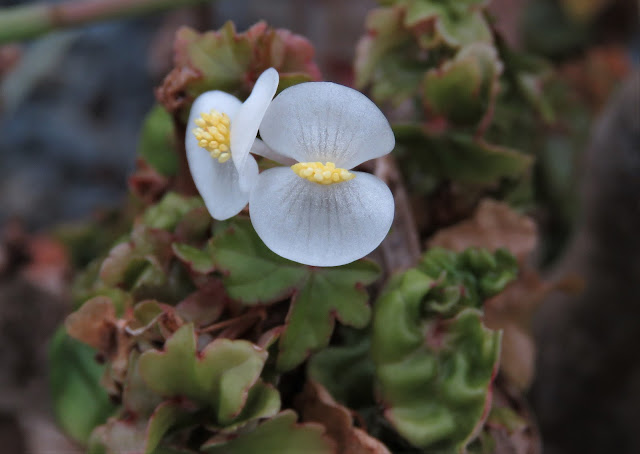Our bulbous begonia with scrunchy, maple-like leaves
Somewhat poetically, while I was in the nursery photographing massonia (see last week's post), I was shown an intriguing begonia. It also comes from South Africa.
Peter Sharp, in his book Down to Earth with Begonias (Forty South Publishing, Hobart; 2013), calls Begonia dregei a 'shrub-like' and 'semi-tuberous' form, which along with some of its relatives should, 'with a bit of luck and careful husbandry, make good garden plants'.
As you can see here, it has a bulbous base, and those scrunched leaves. The flowers are flowers small and white, but of the typical begonia form. These are all male flowers.
Later in his book, Peter adjusts his advice slightly, saying he doesn't generally recommend the semi-tuberous begonias for growing in home gardens. While most are from South Africa, he says they would do better in tropical areas.
That's because they don't like cold winters and readily lose their leaves - although the leaves return in spring.
Begonia dregei was first gathered for science in 1836, from the Cape in South Africa by the German plant collector Johann Drège. It was formally described and named (after Drège) in the same year by two compatriots, Chrisoph Otto and Albert Dietrich. Begonia enthusiasts have grown and crossed this species ever since.
One common name is the Maple-leaved Begonia, for the obvious reason. However the American Begonia Society consider this name confusing because many of the thick-stemmed begonias from South America have leaves of this shape.
Those other maple-leaved begonias are sometimes treated as separate species, and sometimes as varieties of Begonia dregei. It seems that many of these variants grow in 'small, isolated populations' and even in nature 'hybridise easily with one another'.
I'm going to assume our specimen is true Begonia dregei and as the only maple-leaved begonia in our collection - albeit with scrunched up leaves - it can be the Maple-leaved Begonia too. Funny old thing.





Comments